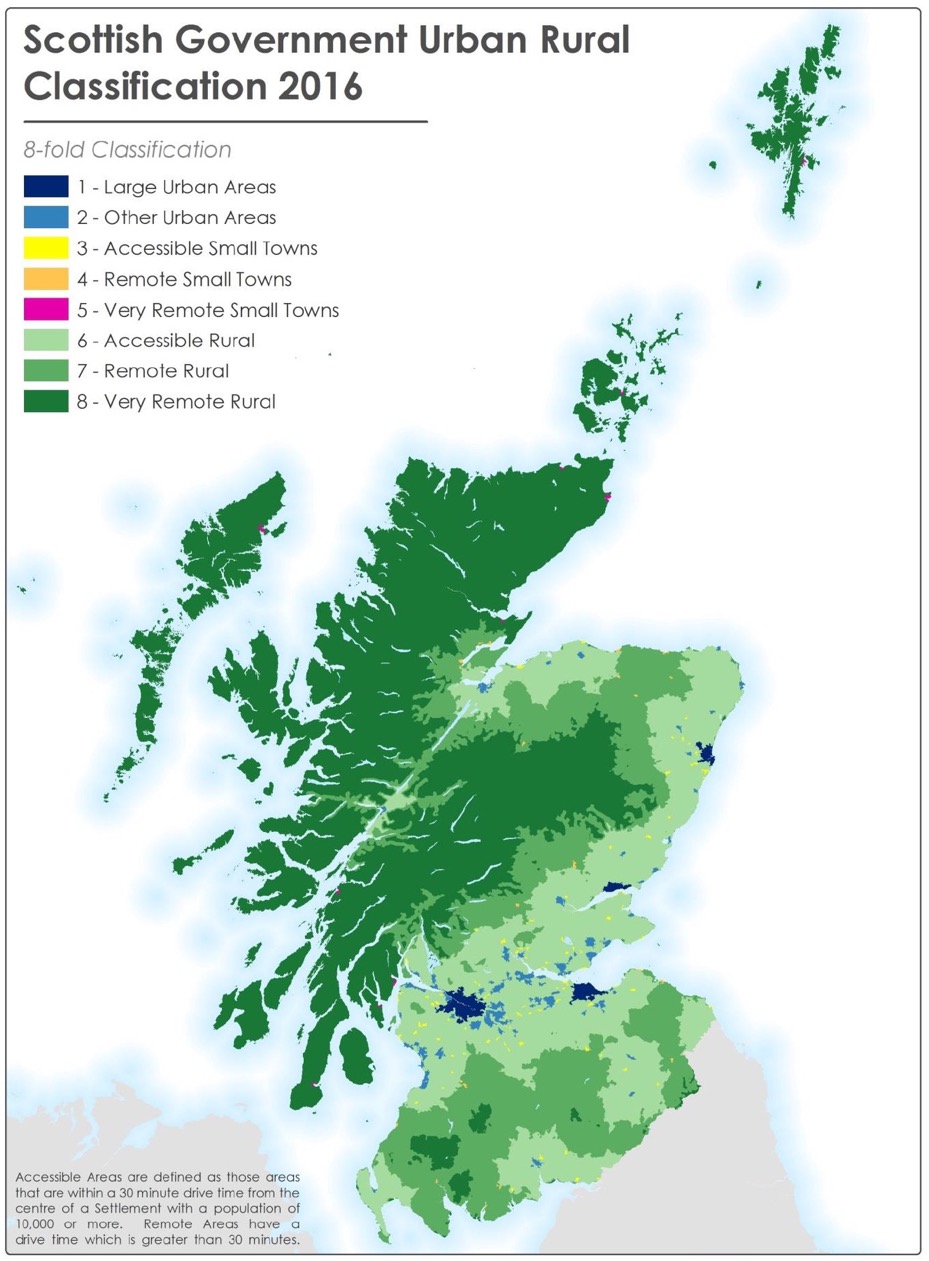*** ARCHIVED ***
This ScotPHO web section has been archived and is no longer being updated or checked for accuracy, out of date information, broken links, etc. Its content should not be considered current or complete. This web section was archived on 9th May 2023. It was previously published under the Wider Determinants main menu heading.
Rurality: introduction - ARCHIVED
The health and wellbeing of a population is influenced by a wide range of factors, including its demographic structure, the availability of housing and employment, accessibility of services, physical environment, social networks, along with levels of crime and safety. These factors are - in turn - systematically different between urban and rural areas. Although most of the Scottish land mass is rural, most of the population lives in urban areas. This section explores some of the key differences between urban and rural areas in Scotland which are likely to have a profound influence on the populations’ health and wellbeing and on the provision of health and social care services.
The Scottish Governments Urban / Rural Classification provides a standard definition of rural areas in Scotland and includes both a 6-fold and 8-fold classification form. This system classifies each of Scotland’s 519 Settlements into a category, based on 2016 data. Table 1 outlines the categories in the 8-fold classification. A settlements classification is based upon two criteria: its population size and accessibility. Population size is defined by National Records of Scotland. Accessibility is defined by driving time, illustrating how important access to a car is in rural areas. The map chart in Figure 1 uses a colour coding scheme to indicate how each Scottish Settlement has been classified.
| Class | Class Name | Description |
|---|---|---|
| 1 | Large Urban Areas | Settlements of 125,000 or more people. |
| 2 | Other Urban Areas | Settlements of 10,000 to 124,999 people. |
| 3 | Accessible Small Towns | Settlements of between 3,000 and 9,999 people and within 30 minutes drive of a settlement of 10,000 or more. |
| 4 | Remote Small Towns | Settlements of between 3,000 and 9,999 people and with a drive time of between 30 and 60 minutes to a settlement of 10,000 or more. |
| 5 | Very Remote Small Towns | Settlements of between 3,000 and 9,999 people and with a drive time of over 60 minutes to a settlement of 10,000 or more. |
| 6 | Accessible Rural Areas | Areas with a population of less than 3,000 people, and within a 30 minute drive time of a settlement of 10,000 or more. |
| 7 | Remote Rural Areas | Areas with a population of less than 3,000 people, and with a drive time of between 30 and 60 minutes to a settlement of 10,000 or more. |
| 8 | Very Remote Rural Areas | Areas with a population of less than 3,000 people, and with a drive time of over 60 minutes to a settlement of 10,000 or more. |
A number of social factors that influence health are more favourable in rural areas compared to the Scottish average. These factors include lower rates of crime, higher neighbourhood satisfaction, and higher rates of volunteering.
However, there are significant challenges that are characteristic of rural living. These challenges are shaped by numerous – upstream - socio-economic and environmental factors, which are known drivers of health inequalities. These factors include, but are not limited to, the following. First, people in rural areas face barriers to education, employment, health & social care services, and essential shops. These barriers are due to the distance and cost required to travel to these respective destinations, which is coupled with limited public transportation services. Additionally, there tends to be a lack of diversity regarding employment opportunities with the dominant sectors in remote rural Scotland being ‘public administration’, ‘agriculture, fisheries, and forestry’, and ‘accommodation and food services’. In accessible rural Scotland ‘public administration’, ‘other activities’, ‘agriculture, forestry, and fishing’, ‘wholesale. retail, and repair’, and ‘manufacturing’ are the largest job sectors. Some employment opportunities are limited as they tend to be seasonal, temporary, and part-time. Addressing these upstream socio-economic factors can help to reduce health inequalities and improve health in rural areas.
Rural areas face unique challenges surrounding mental health issues. The first survey to look at mental health across rural Scotland was conducted in 2017 and is called The National Rural Mental Health Survey Scotland. The findings from this survey have helped to lay the foundations of a mental health evidence base. The majority of respondents reported that lack of public transportation inhibited them from accessing the care they needed and managing their mental health treatment. The majority (80%) of those in Remote Rural areas and half of those in Accessible rural areas reported they felt geographically remote. In addition to this, most respondents reported that they felt they could not be open about their mental health struggles with their local community; with some reporting they felt judged. These factors all contribute to further isolating individuals with mental health difficulties. In fact, one of the key messages respondents wanted to share with policy makers is that “Mental ill health is an invisible illness – made more invisible by being rural and remote”.
Rural areas in Scotland had a relatively lower rate of COVID-19 infections. However, they have been affected by travel restrictions, school closures, reduced access to health and social care, and economic instability. A survey, RuralCovidLife, has been developed by the university of Edinburgh that will investigate the health and wellbeing, social, and financial impact of the pandemic on the lives of those living in rural areas.


